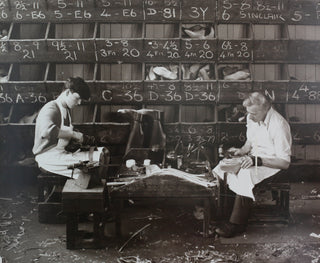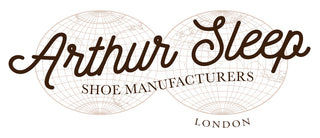
The History of Shoemaking in London
The Timeline
From the first Roman version of the city, London has been a bustling and dynamic centre for trade and craftsmanship, and London’s shoemaking industry has a history dating back as far as the city’s beginnings in 43AD. The worldwide reputation of London's shoemakers can be traced back as far as the Middle Ages, and until the 1960s, a pair of shoes made in London carried the same cache as a suit made on Savile Row.
This timeline traces the rise and fall of the shoemaking trade in London from the city's inception until the present day.

Roman London
London’s founding can be traced to 43 CE, when Roman armies began their occupation of Britain under Emperor Claudius. The soldiers who came and settled in London wore a standard open toed sandal, called a Caliga, with a simple construction and a hobnailed sole. A closed toe winter shoe which tied at the ankle was also common, and the colour of the leather indicated the wearer's status. Despite the construction of most Roman shoes being simple, they could be highly decorated and colourful.
Many examples of Roman shoes have been excavated from the Thames and historic sites across London.


Early Medieval (410-1066)
After the fall of the Roman empire, Europe descended into a period of instability. Multiple different groups fought for control of England, ending with the Normans defeating the Anglo-Saxons in 1066. London was the largest city in Britain by 900.
Most people in this period wore basic footwear, and luxury goods like elaborate shoes were less common. Those that could afford decorated shoes or shoes made of luxury materials used them as symbols of wealth and power. While few documents and materials remain from this period, excavated examples of shoes from London and elsewhere in the UK show the development of the long toed shoes that came to typify footwear in the later Medieval period.


Late Medieval (1066-1485)
The late Medieval period was one of great growth for London, both in terms of population and political power. Westminster developed as the centre of the monarchy, and the City of London became a major European centre of trade and commerce.
Craftsmen in London began to establish guilds to help regulate trade and standardise the calibre of their goods. The Worshipful Company of Cordwainers (shoemakers) was in existence by 1272 and gained a Royal Charter in 1439, which raised the quality of shoemaking in London and led to the development of the first foot measuring and sizing system in 1342.
Poulains (shoes with long pointed toes) were popular with fashionable Londoners, as were Patterns (wooden over shoes, like clogs) which helped keep valuable footwear off of London’s dirty streets. Both styles were worn by rich and poor alike, but only the wealthy could afford highly decorated uppers and impractically long toe shapes.


1500s
The Sixteenth century was a period of radical religious and political change in England. King Henry VIII broke with the Roman Catholic Church and created the Protestant religion, including the publishing of the bible in English. England was also at war with France and Spain during this period, which impacted both trade and fashion.
Despite the political and religious changes, London continued to prosper, and it grew in both size and population. The area around Piccadilly became more metropolitan, thanks to the established thoroughfare that is known as Piccadilly Circus today.
Welted shoe construction was introduced into England in this period, and replaced turn shoes as the most common form of shoemaking. Because of this, poulaines (shoes with long pointed shoes) went out of fashion, and were replaced by the ‘footbag’, also known as the cows mouth, the hornbull, or the bear's paw. These shoes were characterised by their very wide shape around the toes. People across the social scale wore shoes in these shapes, but the wealthy had pairs that were highly decorated with slashing, extra toe shaping and surface design.


1600s
The seventeenth century was a period of great political upheaval in England, including the end of the Tudor era, the English Civil war and the execution of Charles I in 1649, and the restoration of the monarchy in 1660 with King Charles II. These events are reflected in what shoes people wore, from the heavily embroidered mules at the beginning of the century, to the more simple Puritan styles of during and after the civil war, to the flamboyant, heeled silk shoes popular from the 1780s.
Across the seventeenth century, many Protestant Huguenots fled France because of religious persecution and settled in London, bringing with them skills in trades like silk weaving and shoemaking. The majority of the Huguenot shoemakers settled in Piccadilly, an area known for its craftsmanship, and brought new techniques and styles to the London shoemaking trade.
Heeled shoes with square toes were popular with both men and women, often with extensive embroidery. The embroidery would have been done in a separate workshop, and then brought to the shoemakers, a collaborative process that is still common today with highly decorated shoes.


1700s
Georgian England was a contrast of frivolous, extravagant fashion, and the serious political, economic and scientific thought which dominated the Age of Enlightenment. London became the largest city in Europe, and its large population growth led to changes in how people manufactured goods in the city, and how people shopped for them.
London shoemakers began to outsource parts of the shoemaking process to areas in the outskirts of the city or to other parts of the country, but the most skilled parts of the process were still completed in the London workshops. Some London ready to wear shoe manufacturers moved production to Northampton for its cheaper premises and workforce, but London remained the centre of high quality footwear manufacturing.
Shoe shops began to open as separate premises from shoemaking workshops, splitting people's experiences of making and shopping for shoes for the first time. Savile Row developed out of the Burlington estate, and became a centre for tailoring by the end of the century, developing alongside the many shoemakers already in the area.
Huguenot silk, most famously woven in Spitalfields, became a popular choice for shoes for both men and women in the early eighteenth century, while later styles tended to be plainer, square toed and buckled.


1800s
London became the largest city in the world in the 1830s, and Increased globalisation and industrialisation in the 19th century changed how and what shoes were made in London. The Napoleonic war (1810-1819) halted the import of French goods into England, including shoes, and this gave a boost to Londons shoemaking industry.
The American Issac Singer developed the first sewing machine, as we would recognise it today, in 1851, and it was extremely successful around the world. The sewing machine increased industrialisation in Britain, but luxury goods, like high quality shoes, remained at least partially handmade. Shoe sizing became standardised in England in 1885, which boosted both the ready to wear and bespoke shoe trade as shopping for shoes became easier.
There were an estimated 28,974 shoe and bootmakers in London in 1841, and London remained the UK centre of both ready to wear and bespoke boot and shoe production until the 1890s.


1900s
The twentieth century was a period of massive change in England. World War I and World War II, a major economic depression and recession and the collapse of the British empire led to major social, economic and political changes that affected making and design across the country.
Both world wars brought a wave of refugees and immigrants to London, including skilled shoemakers. These shoemakers introduced different construction and decoration techniques to the English trade, and they helped fill the knowledge gap left by shoemaker casualties left after each war.
This was also a period of great experimentation and change in terms of shoe materials, such as the use of cork and wooden soles during WWII, the development of the stiletto heel in the 1950s, and the popularisation of rubber soled sneakers from the 1910s on.
The shoemaking trade in London had been declining since the 1890s, but the rise of fast fashion in the 1960s and higher rents in London meant that most companies either moved out of London or closed in this period. The few shoemakers that survived in central London into the twenty first century specialised in luxury goods such as handmade bespoke shoes.
